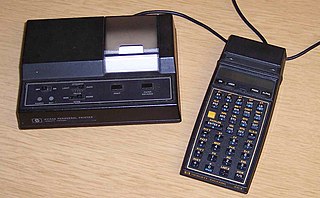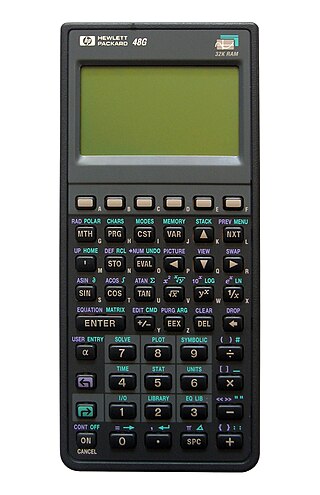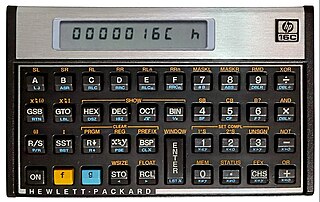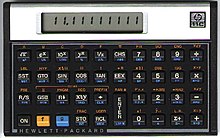Reverse Polish notation (RPN), also known as reverse Łukasiewicz notation, Polish postfix notation or simply postfix notation, is a mathematical notation in which operators follow their operands, in contrast to prefix or Polish notation (PN), in which operators precede their operands. The notation does not need any parentheses for as long as each operator has a fixed number of operands.

William "Velvel" Morton Kahan is a Canadian mathematician and computer scientist, who received the Turing Award in 1989 for "his fundamental contributions to numerical analysis", was named an ACM Fellow in 1994, and inducted into the National Academy of Engineering in 2005.

The HP 33s (F2216A) was a scientific calculator marketed by Hewlett-Packard. It was introduced in 2003 as the successor to the HP 32SII, and discontinued on the introduction of its successor the HP 35s in 2007.

The HP-41C series are programmable, expandable, continuous memory handheld RPN calculators made by Hewlett-Packard from 1979 to 1990. The original model, HP-41C, was the first of its kind to offer alphanumeric display capabilities. Later came the HP-41CV and HP-41CX, offering more memory and functionality.

The HP-42S RPN Scientific is a programmable RPN Scientific hand held calculator introduced by Hewlett-Packard in 1988. It has advanced functions suitable for applications in mathematics, linear algebra, statistical analysis, computer science and others.

The HP-27S was a pocket calculator produced by Hewlett-Packard, introduced in 1988, and discontinued between 1990 and 1993. It was the first HP scientific calculator to use algebraic entry instead of RPN, and though it was labelled scientific, it also included features associated with specialized business calculators.

The HP-12C is a financial calculator made by Hewlett-Packard (HP) and its successor HP Inc. as part of the HP Voyager series, introduced in 1981. It is HP's longest and best-selling product and is considered the de facto standard among financial professionals. There have been multiple revisions over the years, with newer revisions moving to an ARM processor running a software emulator of the original Nut processor. Critics claim that its 1980s technology is antiquated, but proponents point out that it is still the de facto and de jure in high finance.

HP calculators are various calculators manufactured by the Hewlett-Packard company over the years.
Programmable calculators are calculators that can automatically carry out a sequence of operations under control of a stored program. Most are Turing complete, and, as such, are theoretically general-purpose computers. However, their user interfaces and programming environments are specifically tailored to make performing small-scale numerical computations convenient, rather than general-purpose use.

The HP-25 was a hand-held programmable scientific/engineering calculator made by Hewlett-Packard between early January 1975 and 1978. The HP-25 was introduced as a cheaper alternative to the ground-breaking HP-65.

The HP-15C is a high-end scientific programmable calculator of Hewlett-Packard's Voyager series produced between 1982 and 1989.

The HP-16C Computer Scientist is a programmable pocket calculator that was produced by Hewlett-Packard between 1982 and 1989. It was specifically designed for use by computer programmers, to assist in debugging. It is a member of the HP Voyager series of programmable calculators. It was the only programmer's calculator ever produced by HP, though many later HP calculators have incorporated most of the 16C's functions.

The HP-28C and HP-28S were two graphing calculators produced by Hewlett-Packard from 1986 to 1992. The HP-28C was the first handheld calculator capable of solving equations symbolically. They were replaced by the HP 48 series of calculators, which grew from the menu-driven RPL programming language interface first introduced in these HP-28 series.
The term continuous memory was coined by Hewlett-Packard (HP) to describe a unique feature of certain HP calculators whereby the calculator could internally sustain most, or in later models - all, of the contents of user memory. Since its introduction on the HP-25C, this feature slowly evolved by model to eventually mean maintaining the contents of nearly all calculator memory, including system and scratch RAM, options, settings, flags, and other calculator state information.

The HP-34C continuous memory calculator was an advanced scientific programmable calculator of the HP 30 series. It was produced between 1979 and 1983.

The HP 35s (F2215A) is a Hewlett-Packard non-graphing programmable scientific calculator. Although it is a successor to the HP 33s, it was introduced to commemorate the 35th anniversary of the HP-35, Hewlett-Packard's first pocket calculator. HP also released a limited production anniversary edition with shiny black overlay and engraving "Celebrating 35 years".
A graphing calculator is a class of hand-held calculator that is capable of plotting graphs and solving complex functions. While there are several companies that manufacture models of graphing calculators, Hewlett-Packard is a major manufacturer.
HP-10 or variant, may refer to:
In computing FOCAL character set refers to a group of 8-bit single byte character sets introduced by Hewlett-Packard since 1979. It was used in several RPN calculators supporting the FOCAL programming language, like the HP-41C/CV/CX as well as the later HP-42S, which was introduced in 1988 and produced up to 1995. As such, it is also used by SwissMicros' DM41/L, both introduced in 2015, and is implicitly supported by the DM42, introduced in 2017.

The HP-30 or Spice series are RPN Scientific hand held calculators introduced by Hewlett-Packard in 1978. Some models are a programmable.
















